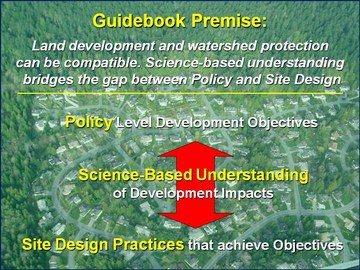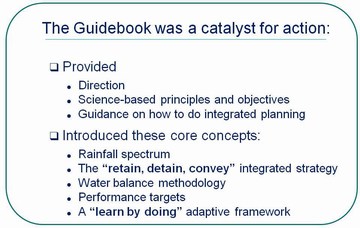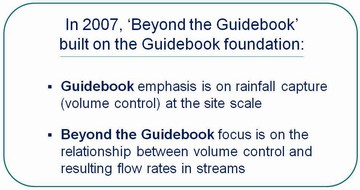Released in 2002, ‘Stormwater Planning: A Guidebook for British Columbia’ has proven to be a catalyst for action
Note to Readers:
The following story is excerpted from Chapter 2 of ‘Beyond the Guidebook 2010’, released in June 2010. To download a PDF version of the 2-page excerpt, click on Watershed Restoration is Achievable.

Catalyst for Action in British Columbia
Release of Stormwater Planning: A Guidebook for British Columbia in 2002 was a catalyst for action to implement a ‘design with nature’ approach to rainwater management and green infrastructure.

Watershed Restoration is Achievable
 “The Guidebook applied a science-based understanding, developed the water balance methodology to establish performance targets, and demonstrated that urban watershed restoration could be accomplished over a 50-year timeframe as and when communities redevelop,” states Peter Law (Ministry of Environment), Chair of the Guidebook Steering Committee.
“The Guidebook applied a science-based understanding, developed the water balance methodology to establish performance targets, and demonstrated that urban watershed restoration could be accomplished over a 50-year timeframe as and when communities redevelop,” states Peter Law (Ministry of Environment), Chair of the Guidebook Steering Committee.
“The premise underpinning the Guidebook was that land development and watershed protection can be compatible. The basis for this premise was that municipalities exert control over runoff volume through their land development and infrastructure policies, practices and actions.”
Landscape-Based Approach
Also in 2002, a Metro Vancouver working group and provincial staff collaborated to produce a discussion paper titled A Watershed / Landscape-Based Approach to Community  Planning. The Guidebook was a pioneering application of this approach.
Planning. The Guidebook was a pioneering application of this approach.
“The premise underpinning the landscape-based approach is that resource, land use and community design decisions will be made with an eye towards their potential impacts on watershed health,” states Erik Karlsen, the principal author and Past-Chair of the Agricultural Land Commission of British Columbia.
Water-Centric Planning Defined
Released in 2004, the Water Sustainability Action Plan for British Columbia incorporated A Watershed/Landscape-Based Approach to Community Planning as a core element. This was rebranded as ‘water-centric planning’ in 2006.

Beyond the Guidebook 2007
In June 2007, Beyond the Guidebook: Context for Rainwater Management and Green Infrastructure in British Columbia was released. By then, practitioners were becoming comfortable with what ‘rainfall capture’ meant in practice. So, it was time to focus attention on how to truly protect and/or restore stream health in urban watersheds.
Beyond the Guidebook initiated the paradigm-shift from the single-function view of traditional ‘stormwater management’ to the integrated and holistic perspective that is captured by the term ‘RAINwater Management’. This also set the stage for defining water sustainability as an outcome of green infrastructure policies and practices.

Beyond the Guidebook 2010
Released in June 2010 at the ‘Dialogue in Nanaimo’, Beyond the Guidebook 2010 describes how water sustainability can and will be achieved through implementation of green infrastructure policies and practices.
 “Beyond the Guidebook 2010 tells the stories of how change is being implemented on the ground in BC; demonstrates that the practitioner culture is changing as an outcome of collaboration, partnerships and alignment; and provides local governments with ‘how to’ guidance for developing outcome-oriented urban watershed plans,” explains Kim Stephens, Program Coordinator for the Water Sustainability Action Plan. He was Project Manager and Principal Author of the 2002 Guidebook.
“Beyond the Guidebook 2010 tells the stories of how change is being implemented on the ground in BC; demonstrates that the practitioner culture is changing as an outcome of collaboration, partnerships and alignment; and provides local governments with ‘how to’ guidance for developing outcome-oriented urban watershed plans,” explains Kim Stephens, Program Coordinator for the Water Sustainability Action Plan. He was Project Manager and Principal Author of the 2002 Guidebook.
To download a copy, click on Beyond the Guidebook 2010: Implementing a New Culture for Urban Watershed Protection and Restoration in British Columbia


